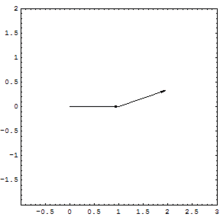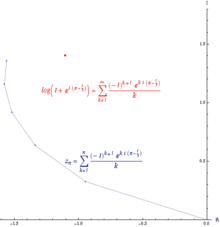Convergent series
In mathematics, a series is the sum of the terms of a sequence of numbers.
Given a sequence  , the nth partial sum
, the nth partial sum  is the sum of the first n terms of the sequence, that is,
is the sum of the first n terms of the sequence, that is,
A series is convergent if the sequence of its partial sums  converges; in other words, it approaches a given number. In more formal language, a series converges if there exists a limit
converges; in other words, it approaches a given number. In more formal language, a series converges if there exists a limit  such that for any arbitrarily small positive number
such that for any arbitrarily small positive number  , there is a large integer
, there is a large integer  such that for all
such that for all  ,
,
Any series that is not convergent is said to be divergent.
Examples of convergent and divergent series
- The reciprocals of the positive integers produce a divergent series (harmonic series):
-
- Alternating the signs of the reciprocals of positive integers produces a convergent series:
-
- Alternating the signs of the reciprocals of positive odd integers produces a convergent series (the Leibniz formula for pi):
-
- The reciprocals of prime numbers produce a divergent series (so the set of primes is "large"):
-
- The reciprocals of triangular numbers produce a convergent series:
-
- The reciprocals of factorials produce a convergent series (see e):
-
- The reciprocals of square numbers produce a convergent series (the Basel problem):
-
- The reciprocals of powers of 2 produce a convergent series (so the set of powers of 2 is "small"):
-
- Alternating the signs of reciprocals of powers of 2 also produces a convergent series:
-
- The reciprocals of Fibonacci numbers produce a convergent series (see ψ):
-
Convergence tests
There are a number of methods of determining whether a series converges or diverges.

 , can be proven to converge, then the smaller series,
, can be proven to converge, then the smaller series,  must converge. By contraposition, if the red series,
must converge. By contraposition, if the red series,  is proven to diverge, then
is proven to diverge, then  must also diverge.
must also diverge.Comparison test. The terms of the sequence  are compared to those of another sequence
are compared to those of another sequence  . If,
. If,
for all n,  , and
, and  converges, then so does
converges, then so does 
However, if,
for all n,  , and
, and  diverges, then so does
diverges, then so does 
Ratio test. Assume that for all n,  . Suppose that there exists
. Suppose that there exists  such that
such that
If r < 1, then the series converges. If r > 1, then the series diverges. If r = 1, the ratio test is inconclusive, and the series may converge or diverge.
Root test or nth root test. Suppose that the terms of the sequence in question are non-negative. Define r as follows:
- where "lim sup" denotes the limit superior (possibly ∞; if the limit exists it is the same value).
If r < 1, then the series converges. If r > 1, then the series diverges. If r = 1, the root test is inconclusive, and the series may converge or diverge.
The ratio test and the root test are both based on comparison with a geometric series, and as such they work in similar situations. In fact, if the ratio test works (meaning that the limit exists and is not equal to 1) then so does the root test; the converse, however, is not true. The root test is therefore more generally applicable, but as a practical matter the limit is often difficult to compute for commonly seen types of series.
Integral test. The series can be compared to an integral to establish convergence or divergence. Let  be a positive and monotone decreasing function. If
be a positive and monotone decreasing function. If
then the series converges. But if the integral diverges, then the series does so as well.
Limit comparison test. If  , and the limit
, and the limit  exists and is not zero, then
exists and is not zero, then  converges if and only if
converges if and only if  converges.
converges.
Alternating series test. Also known as the Leibniz criterion, the alternating series test states that for an alternating series of the form  , if
, if  is monotone decreasing, and has a limit of 0 at infinity, then the series converges.
is monotone decreasing, and has a limit of 0 at infinity, then the series converges.
Cauchy condensation test. If  is a positive monotone decreasing sequence, then
is a positive monotone decreasing sequence, then
 converges if and only if
converges if and only if  converges.
converges.
Raabe's test
Conditional and absolute convergence


For any sequence  ,
,  for all n. Therefore,
for all n. Therefore,
This means that if  converges, then
converges, then  also converges (but not vice versa).
also converges (but not vice versa).
If the series  converges, then the series
converges, then the series  is absolutely convergent. An absolutely convergent sequence is one in which the length of the line created by joining together all of the increments to the partial sum is finitely long. The power series of the exponential function is absolutely convergent everywhere.
is absolutely convergent. An absolutely convergent sequence is one in which the length of the line created by joining together all of the increments to the partial sum is finitely long. The power series of the exponential function is absolutely convergent everywhere.
If the series  converges but the series
converges but the series  diverges, then the series
diverges, then the series  is conditionally convergent. The path formed by connecting the partial sums of a conditionally convergent series is infinitely long. The power series of the logarithm is conditionally convergent.
is conditionally convergent. The path formed by connecting the partial sums of a conditionally convergent series is infinitely long. The power series of the logarithm is conditionally convergent.
The Riemann series theorem states that if a series converges conditionally, it is possible to rearrange the terms of the series in such a way that the series converges to any value, or even diverges.
Uniform convergence
Let  be a sequence of functions.
The series
be a sequence of functions.
The series  is said to converge uniformly to f
if the sequence
is said to converge uniformly to f
if the sequence  of partial sums defined by
of partial sums defined by
converges uniformly to f.
There is an analogue of the comparison test for infinite series of functions called the Weierstrass M-test.
Cauchy convergence criterion
The Cauchy convergence criterion states that a series
converges if and only if the sequence of partial sums is a Cauchy sequence.
This means that for every  there is a positive integer
there is a positive integer  such that for all
such that for all  we have
we have
which is equivalent to
See also
- Convergent sequence
- Normal convergence
- List of mathematical series
- Divergent series
External links
- Hazewinkel, Michiel, ed. (2001), "Series", Encyclopedia of Mathematics, Springer, ISBN 978-1-55608-010-4
- Weisstein, Eric (2005). Riemann Series Theorem. Retrieved May 16, 2005.
| ||||||||||||||||||||||||||||||||||













![r = \limsup_{n\rightarrow\infty}\sqrt[n]{|a_n|},](../I/m/f591b000d3bf9a75a066ab20b4f3ed2b.png)





